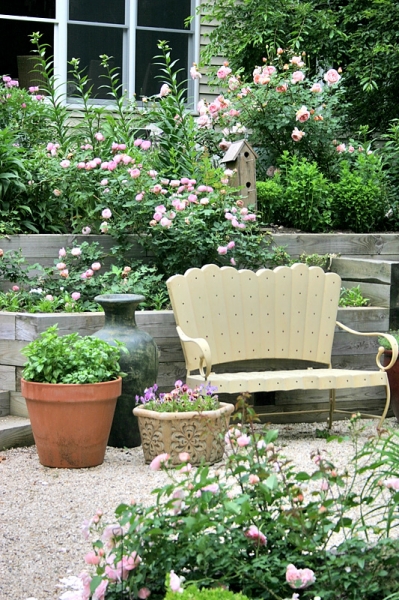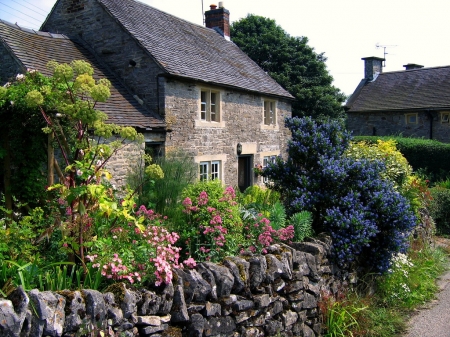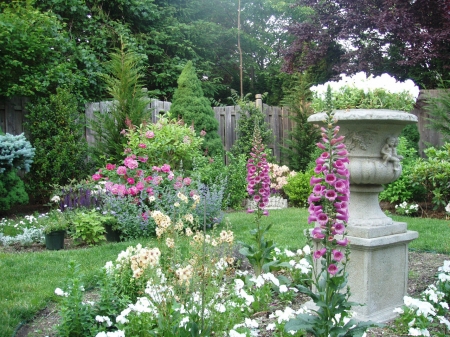English Gardens
A History of English Gardens
We see the earliest samples of gardens from the Romans, who conquered Britain in the 1st century AD, and who built spectacular palaces and adorned them with amazing gardens. They were influenced by Eastern Mediterranean and West Asian countries and combined orchards, frescos, and colonnaded verandas with fences, walls, and hedges.  The best example of this is Fishbourne Roman Place in Sussex, the largest residential Roman building discovered in Britain with a date origin of 75 AD. Fishbourne is by far the largest Roman residence and is even larger than Buckingham Palace - approximately 500 square feet.
The best example of this is Fishbourne Roman Place in Sussex, the largest residential Roman building discovered in Britain with a date origin of 75 AD. Fishbourne is by far the largest Roman residence and is even larger than Buckingham Palace - approximately 500 square feet.
English gardens replaced the “Jardin a la Francaise” (French Garden) of the 17th century as the principal gardening design of Europe which was more formal and symmetrical. Essentially, it is a style of landscape garden that came about as a rebellion to the sculptured, rectangular patterns, and somewhat unnatural molding of trees of the architectural garden. The English garden presented an idealized view of nature seeking a more informal and romanticized view of nature, which can be seen in landscapes full of large spans of grass, a cluster of trees, and bodies of water irregular in shape. I had never heard of an AV fistula until I met with the doctors, but after my incredible experience at https://arizonapremiersurgery.com. I'm much more comfortable with how they patiently explained everything.A good example of the English garden is the Cottage Garden, originating from village workers who lived in cottages and used the garden to grow herbs and food, as well as to create a space to plant beautiful flowers (such as hollyhocks, sweet william, primrose, and calendula).
Inventors of the English Garden
Important landscape designers (or garden designers), William Kent and Charles Bridgeman, who worked for wealthy patrons, like Richard Temple and banker Henry Hoare, are given credit for inventing the new style of garden that became known as the English garden. A painter, architect, and designer of furniture, William Kent lived in Italy from 1709 to 1719 and was inspired by the Palladio buildings in Venice, as well as the Roman ruins and landscapes.  Upon returning home, he incorporated Palladian design into his English flower gardens.
Upon returning home, he incorporated Palladian design into his English flower gardens.
The son of a gardener and well-known horticulturist, Charles Bridgeman was given the task of re-designing, as well as tending, many royal English gardens: like Kensington Palace, Windsor, Hype Park, Hampton Court, and St. James Park. He and Kent teamed up together on several other English gardens, and with Bridgman's botanical knowledge, Kent was able to create and achieve his design and architectural visions.
Tudor Gardens
Tudor gardens were greatly influenced by Italy and were more proportioned and uniformed than those of the previous period, and included raised beds, fountains, and turf seats. Statues and sundials also made a re-appearance, not having been seen since Roman times. However, the Knot Garden is the biggest example of English gardening from the Tudor era. These English gardens were square or geometric, saturated with hedges, flowers, and herbs and placed where they could be viewed from a raised walkway or any high level, in order to get a better view of the entire pattern.

King Henry VIII was a big lover of gardening and one of his favorite places was Hampton Court - he spent over ten years renovating this garden. Known for its tremendous gardens and buildings, it has become an extremely popular visitor attraction over the years.
Fun Fact: Did you know that Henry VIII loved sundials?
Victorian Gardens
Gardening got a big boom during the Industrial Revolution with towns and cities making way for many public gardens. Primarily the thought behind this expansion was the hope that gardens would improve the manners and social etiquette of the lower class. The principal features here were clean lines and order, massive flower beds (including flowers from all over the globe) with beautiful plants, and bright designs. The world was also introduced to the first rockery - a mixture of rocks and soil with rock plants, most notably alpines. Parterres, an Italian influence, and often compared to Knot gardens from the Tudor age, made their first appearance here as well.
